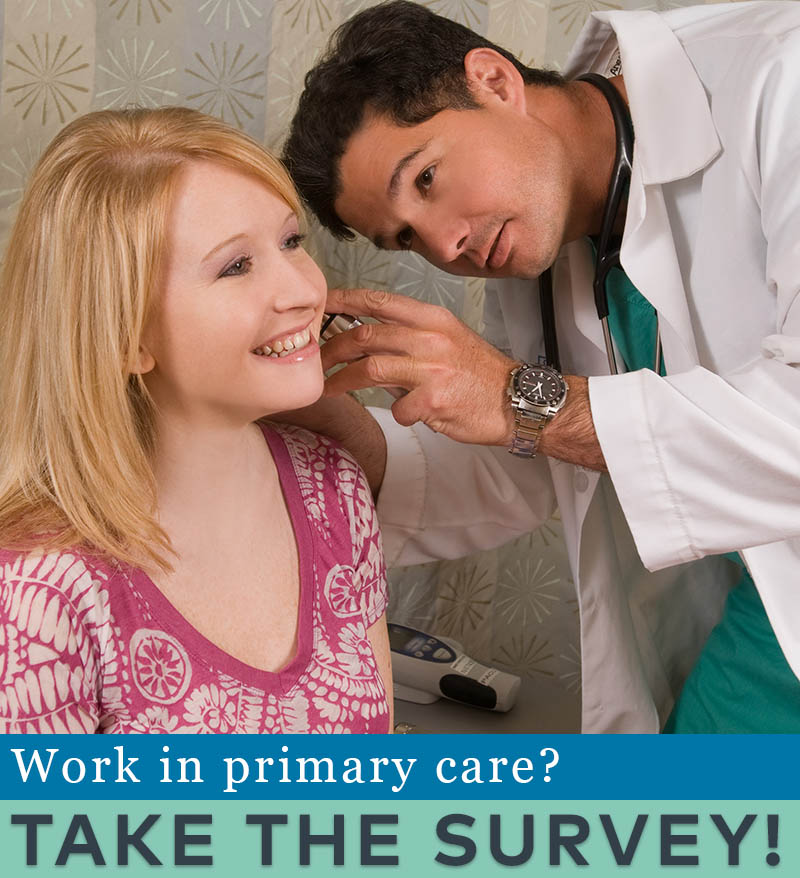You are looking at an archived version of our site. Please visit thepcc.org for a fresh, new experience!
You are here: Array » Primary Care & COV ...
Primary Care & COVID-19: Week 20 Survey
Check back regularly for the latest survey results and updates.
For data from the previous survey, see Week 19 Results.
Who replied to the survey in Week 20?
The Primary Care Collaborative is partnering with the Larry A. Green Center to regularly survey primary care clinicians and patients to better understand the impact of COVID-19 in real time.
Nearly 500 primary care clinicians responded to the survey fielded September 4-8, 2020. Respondents hailed from 49 states and the District of Columbia. Six states represent over half of the responses: Texas, Virginia, Oregon, California, Washington, and South Dakota. Respondents’ specialties include family medicine (70%), internal medicine (13%), pediatrics (6%), geriatrics (5%), mental/behavioral health (1%), pharmacy (0.2%), and other (4%). A quarter of respondents are physicians, followed by nurse practitioners (17%), PAs (4%), and other (3%). Just under a quarter of respondents work in a rural practice; 13% work in a community health center; and 9% are located in an office, school or college. A third of respondents work in a small (1-3 clinician) practice. A small percentage of respondents work in primary care/convenience care settings (7%) or direct primary care/membership settings (4%).
Results at a glance
Staffing shortages continue to plague primary care practices as both staff and clinicians face child care barriers and other demands. A third of respondents report that their practice has empty positions that they cannot fill. Many say that staff (37%) and clinicians (27%) in the practice are limiting their availability due to child care needs. Elder care needs also pose challenges to staff and clinician availability, but to a much lesser extent (8%).
Most clinicians believe that levels of telehealth use are sufficient — or even above what is suitable for patient care. Only around 10% of respondents report that their practices’ use of telehealth is below what would be helpful (due to insufficient funding to increase it); alternatively, over a quarter say that use of telehealth is “above what seems good medicine” but that they need it to maintain patient volume. And, in general, payers continue to be covering it: Over 80% of respondents did NOT report that insurers have pulled back on telehealth (18% said they have).
As federal and state pandemic financial support ends, practices are feeling pressure but still not enough to anticipate closing. Over a quarter (27%) of respondents report “previous pandemic financial support has run out or will soon” as a pressure they will face over the next four weeks. Still, only 3% say that they will likely close before December without additional state or federal support.
With flu season on the horizon, equipment shortages continue to pose an ongoing threat to primary care. Thirty percent of respondents report difficulty obtaining enough COVID-19 testing supplies (e.g., swabs, reagents) to meet their office needs. Another quarter (26%) are having difficulty getting personal protective equipment for staff and clinicians. A smaller percentage of respondents (8%) say that they are unable to buy needed supplies for flu season.
Front-line primary care clinicians are both mentally strained by, and personally committed to, serving patients during these challenging time. Half (49%) of respondents say that their mental exhaustion from work is at an all-time high. Twelve percent report that members of their practice have left primary care because of the pandemic. Yet, even under such mental strain, those that have stayed are feeling committed: A fifth of respondents report that their “sense of purpose in primary care is at an all-time high.”
Learn more: Download the Series 20 Clinician Survey Executive Summary (includes select open-ended answers to survey questions)
Voices from the Primary Care Front Lines
To come
| Fichier attaché | Taille |
|---|---|
| 758.51 KB |

Are you a physician, nurse practitioner, or PA working in primary care?
Help PCC and the Larry A. Green Center track how your practice is responding to the COVID-19 outbreak by completing the Green Center's occasional survey.
The regular surveys are no longer being conducted.
COVID-19 Updates
May 9, 2022 | Primary Care Collaborative
April 19, 2022 | Primary Care Collaborative
April 19, 2022 | Primary Care Collaborative
March 7, 2022 | STAT
February 27, 2022
- 1 of 39
- suivant ›

Recent News
August 16, 2024
August 12, 2024
July 16, 2024
May webinar highlights: “The Commercial Market: Alternative Payment Models for Primary Care” Nate Murray explains w… https://t.co/KX9Wi2w6oY —
Il y a 2 années 6 mois
@CMSinnovates’ primary care strategy is rooted in a 2021 @theNASEM’s report which called #primarycare “foundational… https://t.co/glbPxvCysg —
Il y a 2 années 6 mois
@CMSinnovates has a new #primarycare strategy, envisioning “ACO-based primary care model tests that may focus on pr… https://t.co/aJGF1z411l —
Il y a 2 années 6 mois
- Page 1
- ››
Secondary menu
Copyright © 2024 Primary Care Collaborative




